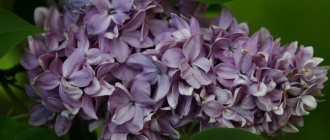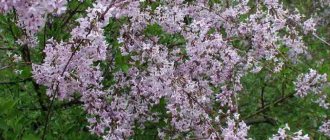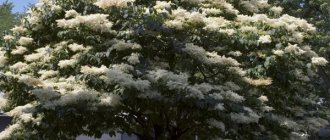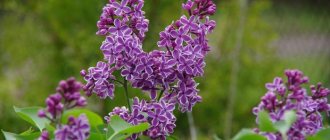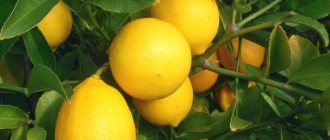13278
Not so long ago, landscape designers proclaimed the fashion for compact lazy gardens. Dwarf lilac is often used for landscaping mini-gardens; its varieties are diverse; it differs from other crops in its ease of care, low regenerative properties, and resistance to environmental influences. In accordance with the established concept, owners of suburban areas have the opportunity to save their energy and time on caring for plant compositions and flower beds.
Lilac hedge
Meyer lilac: description
The compact bushes of this plant are not taller than 1.5 meters. Its branches are colored gray-brown, the bark has small cracks. Young shoots have a dark brown tint. The leaves are elliptical, wide, two to four centimeters long. They taper at the top, the base is wedge-shaped, with tiny “cilia” along the edge. Their upper part is dark green, the lower part is slightly lighter, the leaves are pubescent along two veins that run from the very base parallel to the edges.
Meyer lilac has an exquisite, subtle aroma. The flowers are collected in erect inflorescences. Their length is up to 10 cm. The plant is undemanding to soil, develops successfully even on poor soils, and tolerates moderate watering. Practically does not suffer from frost.
It is better to plant fragrant bushes in groups, in the form of a hedge, although single plantings in a flowerbed look very impressive.
Planting and care
Meyer lilac is a very unpretentious crop . She is not picky about the composition of the soil, but prefers a lot of sunlight.
Features of care
This variety is quite easy to care for and maintain. Moderate watering, rare fertilizing and regular pruning are all the crop needs. However, some features should still be paid attention to so that the plant grows beautiful, healthy and pleasing to the eye.
Landing place
For planting, you should choose sunny, well-lit areas. In addition, you should pay attention to the composition of the soil. Meyer Palibin generally tolerates any soil well. But neutral or slightly acidic soil is what is needed for shrubs.
It is better to choose neutral soil for the variety
Too wetlands are not desirable for this variety; lilac is much better suited to soils with a lack of moisture.
Fertility is not the most important factor for the Meyer variety. It grows well even in poor soil.
How to prepare Meyer lilacs for planting
The period for harvesting seedlings (they are green cuttings) may occur during the flowering period of the plant. Therefore, you have to choose a shoot that has neither buds nor flower buds.
The length of the green cutting should be about 20 cm. The cutting should have at least two buds and a pair of leaf blades.
Before planting the cuttings, it is recommended to keep them in a growth stimulator solution.
Then the cuttings are planted in open ground. A mixture of peat and sand is required as soil. The cuttings are covered with plastic bottles on top or planted in a greenhouse.
to periodically moisten the cuttings , and also control that the temperature in the greenhouse should be three degrees warmer.
You can replant it to a permanent place next summer.
Landing
It is best to plant seedlings the following summer after planting.
The size of the planting hole should be equal to the size of the root system. Approximate dimensions: 50 cm by 50 cm.
If the soil is too poor , then it is recommended to make the hole a little larger and add the following ingredients to it:
- Wood ash;
- Humus;
- Phosphorus fertilizers.
You should not choose a time of day when the sun is very hot. It's better to do this in the evening. If the seedlings have an open root system, it is recommended to trim off the damaged roots. And cut off roots that are too long and powerful so that their length is about 30 cm.
Cover the root system completely with soil and compact it.
Caring for the seedling after planting
After planting, the seedling must be immediately watered with plenty of water. Then the area around the trunk of the seedling must be mulched. The thickness of the mulch layer should be five centimeters.
During the first year after planting the seedling, it is necessary to loosen the soil. The depth should be about 5 cm. This procedure is required about 4 times a year.
Loosening the soil is a useful procedure not only for lilacs
Lighting and temperature
Meyer lilac prefers to grow in places that receive enough sunlight . Of course, you can choose partial shade, but the varietal and decorative properties of the crop are much better manifested in sunny areas.
In general, Meyer is a winter-hardy crop. However, in very harsh winters it may freeze, but recovers quite quickly. To avoid this, it is recommended to plant lilacs in places that are protected from the winds.
Soil condition
The culture grows well on any soil. It is better if it grows on neutral or slightly acidic soil. If the soil is overly acidic, it is recommended to add limestone.
soils that are too swampy , so planting it in lowlands is not advisable, but it is possible if there is a high-quality drainage layer.
Humidity and watering
Watering should be regular but moderate. The plant tolerates a lack of moisture much better than its excess. Because stagnation of water is dangerous due to rotting of the root system.
Overwatering is very dangerous due to root rotting
Air humidity is not significant for the crop, so no additional procedures to increase air humidity are required.
Reproduction
The culture is propagated by the following methods:
- Cuttings;
- Seeds;
- By layering.
Seeds can be sown in autumn or spring . At the same time, if you sow seeds in the spring, they must first be stratified.
The crop is usually propagated from cuttings at the flowering stage. However, you should choose a cutting that does not have buds or flower buds.
To propagate by cuttings you will need:
- Choose a shoot without buds and buds;
- Cut a cutting, the length of which will be no more than 20 cm;
- The cuttings must have at least 2 leaves ;
- For several days, treat the media in a solution of a growth stimulator;
- Plant the cuttings in a substrate of sand, which should be moistened by 2-3 cm, or directly into open ground.
To propagate by layering, you should select a young shoot with buds, press it to the ground and sprinkle it with earth. When the cuttings take root, they must be separated from the mother plant and transplanted to a permanent place of growth.
Top dressing
Lilac, a photo of which you can see in this article, is very responsive to feeding. Two such procedures per year are quite enough for her. In the spring, with the melting snow, the bushes are nourished for the first time and after flowering for the second time. If a chemical analysis of the soil on the site has not been carried out, then it is better to use ready-made fertilizers (complex) for flowering shrubs. Today they are offered in large quantities by specialized trading organizations.
Meyer lilac is resistant to many diseases. Sometimes it can be affected by viruses. The first two years before wintering, young bushes are covered with material; tree trunk circles should be mulched with leaves or peat.
Diseases and pests
This type of lilac has good resistance to many diseases and pests. In conditions of too humid summer it can be affected by powdery mildew, which can be successfully combated by spraying with any fungicide.
When pests are detected (bud mite, lilac leaf beetle, leaf miner), the lilac is treated with insecticides.
Sometimes it is affected by viruses, which are useless to fight. You just need to monitor the health of the planting material and provide the plant with proper care.
Reproduction
Varietal plants, which include Meyer lilac, are propagated by cuttings, grafting or layering. Lilac seeds are usually collected in early October. They can be sown in autumn or spring. If you want to sow them in the spring, you must first stratify them.
Lilac cuttings are carried out during active flowering. Cuttings are cut from one-year-old shoots, from the middle part. The substrate for them is a mixture of sand with vermiculite, perlite or river sand (purified). The grafting is carried out with a cutting, or a dormant bud. For the rootstock, Hungarian lilac, common privet, and common lilac are used.
Grafted plants are grown in the form of a semi-standard, bush or standard form. The formation of a standard should begin in the second year after grafting. The stem should not exceed 1.5 meters in height. Standard lilac needs special care - you need to ensure that the main shoot is not covered with shoots.
Advantages and disadvantages of low-growing lilac
Among other mini-shrubs, dwarf lilac has a number of advantages. These include:
- High frost resistance. Some varieties are able to withstand temperatures down to -40 °C without additional insulation.
- Easy to care for. One organic feeding is enough for a young plant for 2-3 years.
- Drought resistance. The shrub can withstand the heat for up to 7 days without additional irrigation.
- Low vegetation potential. Perennial dwarfs have a slow growth rate, so gardeners do not have to worry about crown density.
- The ability of the crown to absorb exhaust gases and toxic volatile compounds from the surrounding atmosphere.
Shrub formed in the form of a trunk
Among the disadvantages, it is worth noting the low rooting rates. Most low-growing varieties (except Mayer's species) suffer from disease for a long time after transplantation to a new location. In the first 2 years after the manipulations, plants need more careful care.
Syringa Meyeri Palibin
There are several varieties of this type of lilac. We will introduce you to them. The most popular and sought after of them is the Meyer Palibin lilac. This is a deciduous shrub. The crown is very compact. The leaves are arranged oppositely, broadly elliptical or ovoid in shape. Their length is about 4 cm, width - 2.5 cm, on top they are completely smooth, dark green, the lower part is much lighter, sometimes pubescent along the veins, the edges are slightly wavy.
The flowers are located at the ends of the shoots and are light purple in color. There are always a lot of them and they have a strong aroma. Erect inflorescences up to 10 centimeters long. Blooms at the end of May. Meyer lilac Palibin is a remontant variety. This means that it blooms again. This usually occurs in late summer, but not as abundantly and luxuriantly as in spring.
Pruning shaping a lilac bush
This procedure is carried out in parallel with the sanitary removal of unnecessary parts of the plant, but in addition, the following must also be removed:
- dry dead branches;
- 1/3 of all outer stems.
- skeletal branches directed to the center of the bush;
- the upper third of all lateral shoots.
Pruning shaping a lilac bush
For your information! The tops are formed by cutting already from the 3rd season. It is difficult to form an adult plant at one time; divide it into two seasons. To begin with, trim off the basal shoots and weak branches, and in the second season, remove all remaining unnecessary stems.
Growing
This type of lilac is frost-resistant, light-loving, but at the same time tolerates partial shade well. It loves fertile, slightly acidic or slightly alkaline moist soils, but does not tolerate flooding.
Planting holes are filled with compost or humus mixed with garden soil. Fertilizing is carried out twice a season. Adult bushes are pruned, dying, old shoots that grow inside the crown are removed. Excess growth is removed from grafted plants. Standard bushes are pruned more intensively.
Palibin lilac seedlings can be shaped into a ball, a bush, or given a standard shape. This cute dwarf tree does not exceed 60 cm. In this form it can be used both for growing in a personal plot and as a potted plant.
At least three to four times a season it is necessary to loosen the soil (not too deep) - about five to six centimeters. Lilac Palibin is suitable for group and single plantings, for creating fairly dense hedges.
Preventive autumn treatment of lilacs
In autumn, preventive spraying of lilacs against fungal infections will be required:
- Bordeaux mixture (3%);
- iron sulfate (3–5%).
For preventive treatment of lilacs against fungal diseases, you can use Bordeaux mixture and iron sulfate.
After dropping the leaves, lichens and mosses are removed from the branches, then the soil in the tree trunk is dug up shallowly (5–10 cm). The root system of lilacs is superficial, so it is important not to damage the roots. After this, they spray on bare branches.
You need to spray lilacs on bare branches in the fall.
Red Pixie
Another great low growing and hardy plant. The Meyer Red Pixie lilac blooms twice a year. The first time at the end of May, the second at the end of July - beginning of August. The bush is compact, quite dense. Its height can be from 100 to 170 centimeters, width about 120 centimeters.
The buds are purple-red. The flowers initially have a rich pink hue, then become light pink. Surprisingly, this plant begins to bloom very early. Very small bushes (25 cm) are covered with numerous inflorescences, emitting a stunning aroma. This plant is ideal for a small garden.
Red variety
Red Pixie lilacs have vibrant purple and red flowers that lighten over time. This plant is very hardy and low growing and is also remontant. Its first flowering occurs at the end of May, and the second at the transition from July to August. The bush forms quite densely and can reach a height of 170 cm, although on average its height is about a meter. The width of the bush reaches 120 cm. The first flowering of lilacs of this variety occurs at an early age, when the bushes do not yet exceed 25 cm in height. Red Pixie has an excellent aroma and this lilac will undoubtedly decorate any area.
Bloomerang Ash
A remontant variety, which is a complex hybrid of large-leaved, spreading, Meyer and Juliana lilacs. The bush is compact, height about 150 cm, width no more than 160 cm. It blooms for the first time in May, the second time in August. But what is especially important is that the color lasts until frost.
The flowers have a delicate lavender hue and a rich aroma. This lilac is unusually good in bouquets - early in the morning you need to cut off two thirds of the flowering branch, put it in water, splitting the cuts at the ends. When they bloom again, the inflorescences are smaller in size and more saturated in color. To improve secondary flowering, remove faded panicles after the first wave. This species is used in small gardens as a decoration on lawns or to create original compositions.
The best varieties and varieties
There are not many varieties of Meyer lilac, but they are all in demand and popular with gardeners. Known varieties:
“José” is a hybrid variety that was developed by crossing 3 types of lilac: Meyer, open and small-leaved. Bushes up to 150 cm high and wide. Small leaves with a pointed end. The inflorescences are paniculate, the flowers are lavender-pink. At the end of summer, lilac blooms weakly for the second time; repeated flowering depends on the level of illumination and soil moisture. Flowering will be more intense if dry inflorescences are removed in time.
"Red Pixie" is a hardy remontant variety. Differs from other varieties in the purple color of the flowers.
A series of “flowerfest” varieties (“white”, “pink”, “purple”). The width of the bushes is 100 cm, the height is from 80 to 120 cm. The leaves are small, dark green. The color of the flowers depends on the specific variety (white, pink or purple). The length of the inflorescences is standard for compact lilacs - 10 cm. First flowering period: from May to June. Blooms again in early August (sometimes at the end of July).
“Tinkerbell” - the bushes have a spreading crown and can stretch up to 150 cm. They bloom with small fragrant pink flowers twice: in early June and early September.
“Bloomerang Ash” is a hybrid remontant variety, the height of the bush can reach 150 cm, width - 180 cm. The first flowering occurs in May, the second one - at the end of summer. Purple flowers remain on the branches until autumn frosts.
Photo: collage © Vosaduli.ru
Dwarf
Dwarf Meyer lilac is represented by the variety "Palibin". The crown is rounded, the branches of the bush are gray-brown in color. The leaf shape is heart-shaped, the color is dark green. The leaves are small and shiny, densely covering the branches. The inflorescences are straight, elongated, their length reaches 8-10 cm. The flowers are lilac-pink, turning into pale purple towards the end of flowering. Bushes of this variety are resistant to lack of moisture in the soil. They grow slowly. Their height usually reaches 60 cm. The flowering period begins at the end of May or June - depending on weather conditions. The variety can be grown not only on the site, but also at home. It is suitable for planting in urban areas.
Meyer's "Flowerfest" lilac is a remontant crop. Depending on the color of the flowers, it is divided into 3 varieties:
- "white" (white flowers);
- “purple” (purple);
- "pink" (pink).
The height of “flowerfest” lilac is about 100 cm, individual bushes can stretch up to 120 cm. Compared with other varieties, this variety has the most abundant and long-lasting flowering - it blooms again until frost. The leaves of dwarf lilac are small, each inflorescence contains many flowers.
The crop is resistant to pests and diseases, to damage from root rot and powdery mildew. Withstands frosts.
Suitable for growing in small areas. Prefers well-lit places, but will also grow in slightly shaded areas.
Reds
The description of the remontant variety “red pixie” is as follows:
- the height of the bush can reach up to 170 cm, width - up to 120 cm;
- flowering occurs twice per season - in May and in the second half of summer;
- red tubular flowers gradually acquire a pink color;
- leaves are round in shape, with a barely noticeable protruding tip, dark green in color and glossy surface;
- persistent aroma.
Requires minimal care. It grows well in sunny areas, but does not tolerate stagnant moisture in the soil.
Pink and purple
The remontant variety “José” is a hybrid, characterized by fragrant purple-pink flowers. Its low bushes grow extremely slowly. During flowering, the tubular flowers emit a sweet aroma. It blooms for the first time towards the end of May - beginning of June. The second flowering begins in August. Grows well in sunny places. On dry days it requires abundant watering. The variety is resistant to powdery mildew and frost-resistant.
Another dwarf lilac variety with pink flowers is Tinkerbell. After flowering it requires mandatory pruning. Grows on fertile and moist soils.
Jose
Another wonderful representative of the “balcony series”. Miniature lilac Meyer Jose is a remontant type. The bush is small, spreading, 1.25 meters wide. The peculiarity of the variety is its very slow growth, so it is often used to decorate mixborders.
The flowers are almost purple with a pink tint, with a strong aroma. This is especially felt during group planting. It blooms for the first time at the end of May (sometimes at the beginning of June). The second time (at the end of August) the flowering is less active.
Like all Meyer lilacs, Jose prefers sunny areas with light partial shade. Feels comfortable on well-drained loams containing humus. It needs additional watering only in dry years.
Blooms in the year of rooting
| Meyer lilac | |
| general characteristics | Tall bush. The shoots are densely branched and directed upward. |
| Size | Height up to cm: 150 Diameter up to cm: 150 |
| Flowers | Mauve |
| Leaves | Widely elliptical, ovoid |
| The soil | Undemanding to soil conditions |
| Illumination | Photophilous, but tolerates slight shading |
| Winter hardiness | Winter hardiness is high. USDA zone 3 |
Common lilac Meyer:
- About the variety. The compact form of the bush, the plant barely reaches one and a half meters in diameter and height. The growth of the bush per year is no more than 10 cm. The leaves are small, green above and light below. The crop can be grown in pots, which is why it got the name “balcony”.
- About flowers. Blooms in the year of rooting. Blooms profusely and is distinguished by early flowering. The remontant culture blooms in May-June and August-September. Flowers range from soft pink to purple-red. The inflorescences are lush, cone-shaped. The second flowering is not so abundant, but decorative.
- About care. Common lilac does not require care. Drought-resistant, tolerates frosts well. The first year after planting, it is recommended to water abundantly and mulch the soil with sawdust or cut grass. Be sure to remove the inflorescences after flowering. Pruning should be done in spring and autumn. The crown is well formed, which is valuable in landscape design.
Igor Bilevich's channel recommends Meyer's dwarf lilac for planting
Video:

